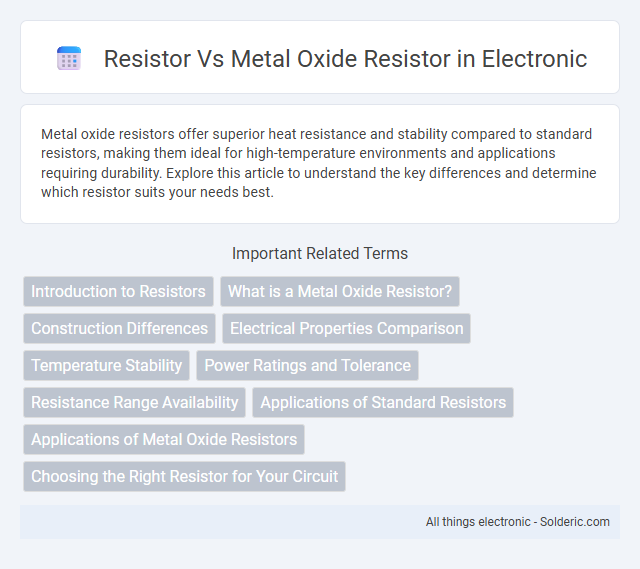Metal oxide resistors offer superior heat resistance and stability compared to standard resistors, making them ideal for high-temperature environments and applications requiring durability. Explore this article to understand the key differences and determine which resistor suits your needs best.
Comparison Table
| Feature | Resistor | Metal Oxide Resistor |
|---|---|---|
| Composition | Carbon film or wire-wound | Metal oxide film on ceramic substrate |
| Temperature Coefficient | Higher, less stable | Lower, more stable |
| Power Rating | Typically 0.25W to 2W | Higher power, up to 5W or more |
| Tolerance | +-5% to +-10% | +-1% to +-5% |
| Noise | Higher noise level | Lower noise |
| Applications | General purpose circuits | High reliability, high temperature environments |
| Cost | Lower cost | Moderate cost |
Introduction to Resistors
Resistors regulate electric current by providing precise resistance in circuits, with common types including carbon film, wire-wound, and metal oxide resistors. Metal oxide resistors offer enhanced heat resistance, stability, and durability compared to standard carbon resistors, making them ideal for high-temperature and high-voltage applications. When selecting your resistor, consider the specific electrical characteristics and environmental conditions to ensure optimal performance and longevity.
What is a Metal Oxide Resistor?
A metal oxide resistor is a type of resistor made by depositing metal oxide film, usually tin oxide, onto a ceramic core, providing higher temperature stability, better voltage handling, and improved flame resistance compared to carbon film resistors. This construction enhances durability and performance in demanding electrical circuits where precision and reliability are crucial. Understanding these benefits helps you choose the right resistor type for applications requiring robust and consistent resistance values.
Construction Differences
Metal oxide resistors are constructed with a metal oxide film, typically tin oxide, deposited on a ceramic rod, providing higher heat resistance and stability compared to traditional carbon film resistors made from a carbon-based material. The metal oxide layer in these resistors offers improved durability and precision, reducing noise and enhancing performance in high-temperature environments. Understanding these construction differences helps you choose the right resistor for applications requiring reliability and thermal endurance.
Electrical Properties Comparison
Metal oxide resistors exhibit higher temperature stability and better tolerance to overloads compared to standard carbon film resistors, making them ideal for high-power applications. Their electrical noise levels are significantly lower due to superior material composition, enhancing signal integrity in sensitive circuits. The resistance values of metal oxide resistors remain more consistent across a wide temperature range, providing reliable performance in diverse environmental conditions.
Temperature Stability
Metal oxide resistors offer superior temperature stability compared to standard carbon film resistors, maintaining resistance values within tight tolerances even under significant temperature fluctuations. Their construction from metal oxide films provides a lower temperature coefficient, typically around +-100 ppm/degC, which minimizes resistance drift. Choosing a metal oxide resistor can enhance your circuit's reliability in environments subject to variable or high temperatures.
Power Ratings and Tolerance
Metal oxide resistors typically offer higher power ratings, often ranging from 0.25 watts up to 5 watts or more, compared to standard carbon film resistors which usually max out at around 0.25 to 0.5 watts. In terms of tolerance, metal oxide resistors generally exhibit tighter tolerances, commonly around +-1% to +-5%, improving precision and stability under thermal stress. This combination makes metal oxide resistors preferable for high-power applications where durability and accuracy are critical.
Resistance Range Availability
Metal film resistors typically offer a resistance range from 1 ohm to 10 megaohms, providing high precision and stability for electronic circuits. Metal oxide resistors cover a broader range, extending from 0.1 ohm up to 100 megaohms, making them suitable for applications requiring higher power dissipation and durability. The extended resistance availability of metal oxide resistors supports their use in harsh environments and power-sensitive designs.
Applications of Standard Resistors
Standard resistors are commonly used in electronic circuits to control current flow, divide voltage, and protect components from excessive current. They are ideal for general-purpose applications like signal conditioning, filter networks, and biasing active devices due to their accurate resistance values and stable performance. Unlike metal oxide resistors, which excel in high-energy surge handling, standard resistors are preferred where precise resistance and low noise are essential.
Applications of Metal Oxide Resistors
Metal oxide resistors are widely used in power supplies, automotive electronics, and industrial equipment due to their high-temperature stability and superior resistance to surge currents. Their ability to withstand harsh environments makes them ideal for applications requiring reliable performance under extreme conditions. You can count on metal oxide resistors for enhanced durability and consistent operation in demanding electronic circuits.
Choosing the Right Resistor for Your Circuit
Metal oxide resistors offer better thermal stability, higher pulse load capacity, and improved tolerance compared to standard carbon film resistors, making them ideal for circuits requiring precision and durability. Choosing the right resistor for your circuit depends on factors like power rating, noise level, temperature coefficient, and environmental conditions. Your selection ensures optimal performance and longevity, especially in demanding electronic applications.
resistor vs metal oxide resistor Infographic

 solderic.com
solderic.com